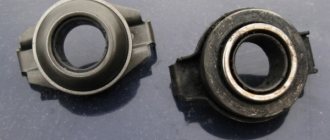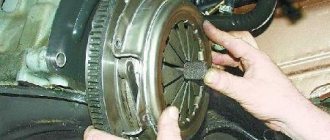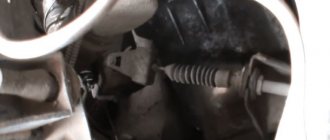In cars with a manual transmission, the clutch needs to be replaced periodically. To replace the mechanism with your own hands, you need to stock up on special equipment and instructions for performing the replacement. If your car's disk mileage ranges from 70 to 150 thousand kilometers, then you should replace the clutch.
But you also need to take into account the operating conditions of the car and the manufacturer of the clutch mechanism that is installed in the car. After analyzing all these factors, you can watch a video about replacing the clutch with your own hands.
Changing the clutch yourself
The cost of a complete clutch replacement can vary depending on the quality of the parts and the availability of the necessary tools for the job.
If you decide to do everything yourself, then without a new release bearing, clutch, disc and basket, cylinders, cable, you will not be able to complete the complete replacement process.
How to properly remove and install a gearbox
If you have a rear-wheel drive car, first disconnect the clutch that connects the manual transmission to the driveshaft. And if your car is equipped with a front-wheel drive mechanism, then start by removing the drive shafts, do not forget to install plugs during replacement. Now disconnect the cables.
Unscrewing the nuts on the mount, remove the input shaft, which is located in the bearing inside the engine flywheel. The appearance of oil stains in the area of the rod indicates a problem with the seal.
Let's start the installation. From special equipment, you will need a winch to rotate the shaft on the gearbox during installation. This way it is guaranteed to fit into the splines that are located in the flywheel. The last stage of installation is the process of adjusting the length of the rod.
Types of clutch
Dry clutch
The principle of operation of this type of clutch is based on the friction force that arises from the interaction of dry surfaces: drive, driven and pressure disks. This ensures a tight connection between the engine and gearbox. A dry single-plate clutch is the most common type used on most cars with a manual transmission.
Wet clutch
This type of clutch involves the operation of the rubbing surfaces in an oil bath. Compared to dry, this scheme ensures smoother contact of the discs; the unit is cooled more efficiently due to fluid circulation and can transmit more torque to the transmission.
Double wet clutch
The wet circuit is usually used on modern dual-clutch robotic gearboxes. The peculiarity of the operation of such a clutch is that the even and odd gears of the gearbox are supplied with torque from separate driven disks. The clutch drive is hydraulic, electronically controlled. Gear shifting occurs with constant transmission of torque to the transmission without interruption in the power flow. This design is more expensive and difficult to manufacture.
Dry double-disc clutch
Double-disc clutch elements
A dry double-disc clutch involves the presence of two driven discs and an intermediate spacer between them. This scheme is capable of transmitting more torque with the same dimensions of the clutch mechanism. In itself, it is easier to produce compared to wet. Typically used on trucks and cars with particularly powerful engines.
Dual mass flywheel clutch
The dual mass flywheel consists of two parts. One of them is connected to the engine, the second to the driven disk. Both components of the flywheel have a slight free play relative to each other in the plane of rotation and are connected by springs to each other.
Dual mass flywheel diagram
A special feature of the dual-mass flywheel clutch is the absence of a spring-loaded torsional vibration damper in the driven disc. The vibration damping function is built into the flywheel design. In addition to transmitting torque, it most effectively smoothes out vibrations and loads arising from uneven engine operation.
Independent work on replacing disks and baskets
You need to start the repair process by unscrewing the bolts in the basket, then you should remove all the parts that are in the flywheel. Pay attention to the surfaces of the flywheel so that there are no traces of oil there.
The driven disk must also be clean; if there are marks, the oil seal must be replaced. Also change the driven disk and basket if you find damage on them in the form of deep scratches. The flywheel and driven disc of the basket must be clean and free of grease. Cleaning can be done with gasoline.
We insert the disc into the basket and put the mount either on the manual transmission input shaft or on the mandrel. There is a hole in the flywheel where we place the entire set of parts. Insert until it stops and screw the basket onto the bolts.
This process must be done two or three times to ensure an accurate and even installation. Now you can tighten the bolts, applying a force of 2.5-3.5 kgf/m. Information about the force power is available in the repair instructions for your car brand. We change the clutch basket according to a similar scheme.
Changing the engine oil with your own hands - step-by-step instructions on how to correctly, quickly and easily change the oil in the engine and transmission (125 photos and videos)Do-it-yourself speed controller - how to make a simple adjustment device or smooth descent (120 photos)
- Can a non-owner apply for compulsory motor liability insurance?
You have replaced the clutch and feel vibration in this area - you need to adjust the centering of the disc or check the tightening power of the basket.
Replacing the clutch disc
Malfunctions of the driven disk are accompanied by slipping of the clutch and are manifested by the presence of a characteristic burning smell as the speed increases and slow acceleration. As well as increased vibrations and increased free play of the clutch pedal.
Materials, tools, replacement progress
The work is carried out in the presence of an inspection hole or overpass, which can, if necessary, be replaced with a winch or jack to lift the front of the car. You will also need to prepare a new clutch disc, a set of wrenches and a flashlight. If you have a hydraulic clutch, you should purchase brake fluid.
Replacement steps:
- depending on the design features of the vehicle, the starter, resonator, driveshaft and exhaust manifold are removed;
- the gearbox is dismantled to facilitate access to the clutch basket;
- The basket cover is removed and the disc is replaced.
It is also recommended to check the condition of the release bearing and replace it if necessary. The disk is installed with centering and good tightening of the basket bolts, which will prevent the formation of vibration when the vehicle is operating. After assembly, the brake fluid level inside the system is checked.
Changing cylinders
There is a reason to change the main cylindrical system if the functionality of the system does not improve after replacing the o-rings. Replacement with new clutch cylinders is installed when the brake fluid runs away even after replacing new cuffs.
Perform the process of removing the working cylinder and installing it according to the following diagram:
- We get rid of the spring near the pedal.
- We unscrew the two nuts that secure the cylinder to the gearbox;
- The process of unscrewing the rubber hose attached to the working cylinder is carried out by weight;
- We screw a new type cylinder to the hose to avoid leakage of the brake compound;
- We pump everything out of the cylinder, unscrew the fitting, close the hole;
- We unscrew the nuts that secure the master cylinder to the car body;
- To release the hinge connected to the pedal, you need to pull it towards you. Pull out the pin, this will release the cylinder from the pedal.
- Install the two cylinders in the same way as you disassembled them.
After replacing the cylinders, bleed the main clutch. When the air stops escaping, the cylinder is installed correctly.
Causes of clutch failure
The causes of clutch failure can be divided into several categories:
- Wear of friction pairs in the clutch mechanism.
Most often, the clutch driven disc wears out. The pressure plate, which cannot receive torque from the driven disk, wears out a little less often. It is very rare for the engine flywheel to wear out.
Most often, wear of friction pairs in the clutch is caused by natural wear and tear during vehicle operation. In this case, only replacing worn clutch parts will help.
Slightly less often, wear occurs due to the fact that the friction pairs do not fit tightly to each other and, because of this, slip relative to each other while the car is moving. The reason for this may be a worn diaphragm spring, which does not create sufficient pressing force. In this case, the clutch basket needs to be replaced.
Also, the reason for the friction pairs not fitting tightly to each other may be a jammed release bearing, which prevents the pressure plate from returning to its original position. In this case, the release bearing must be replaced.
We recommend: Urgent car purchase
A very rare situation occurs when the clutch slave (or master) cylinders jam and also prevent the pressure bearing from returning to its original position. In this case, the clutch master (or slave) cylinder needs to be replaced.
With this malfunction, the clutch slips and an unpleasant smell of burnt brake pads appears. The car urgently needs diagnostics and repairs.
- The clutch drive system is not tight.
On all modern cars, the force from pressing the clutch pedal is transmitted to the release bearing using a hydraulic system. If the hydraulic system is not sealed, sufficient force is not created on the release bearing to press the diaphragm spring. In this case, there is no separation of friction pairs in the clutch. Thus, the transmission input shaft still receives torque from the engine. In this case, it is difficult or impossible to change transmission gears. When you try to change gear, the gearbox gears may crack and grind.
This malfunction requires diagnostics of the hydraulic system, restoration of its tightness or replacement of worn components - the clutch master or slave cylinder.
- Clutch pedal does not operate smoothly.
When you do not release the clutch pedal smoothly, the connection between the driven disc, pressure plate and flywheel occurs too abruptly. Because of this, shock loads occur on the clutch driven disc. The clutch driven disc itself is quite fragile and does not withstand impacts well. From impact loads it begins to crack, and then completely crumble. Operate the clutch pedal correctly and you will protect yourself from this trouble.
Replacing the clutch slave cylinder
First, we disconnect the cotter pin element, which drives the hydraulic drive mechanism itself, using pliers. We use them to remove the spring. We do not scroll the fitting hose completely.
Do-it-yourself engine repair - major restoration and maintenance of an internal combustion engineDIY bumper: how to make a unique polymer bumper for a car at home (125 photos)
Do-it-yourself car painting - preparation for coating and the main stages of high-quality car painting (100 photos)
Using the 13th key, remove the 2 bolts from the crankcase. And only now we take out the pusher. Access to the cylinders is open. How to further replace the working clutch is shown in more detail in the video.
Replace the cable and release bearing
Replacing these parts is advisable after exceeding the 150 thousand mileage mark of the car. By freeing the fork from the spring, you can remove the cable. Unspinning the connection will make it possible to remove the cable from the clutch pedal.
If necessary, replace the entire part. To remove the spent cable, you need to pull out the pin. We install the new one using the same method as you removed it.
You know your car better than anyone, so armed with the appropriate equipment and tools, you can replace the clutch yourself without much difficulty.











